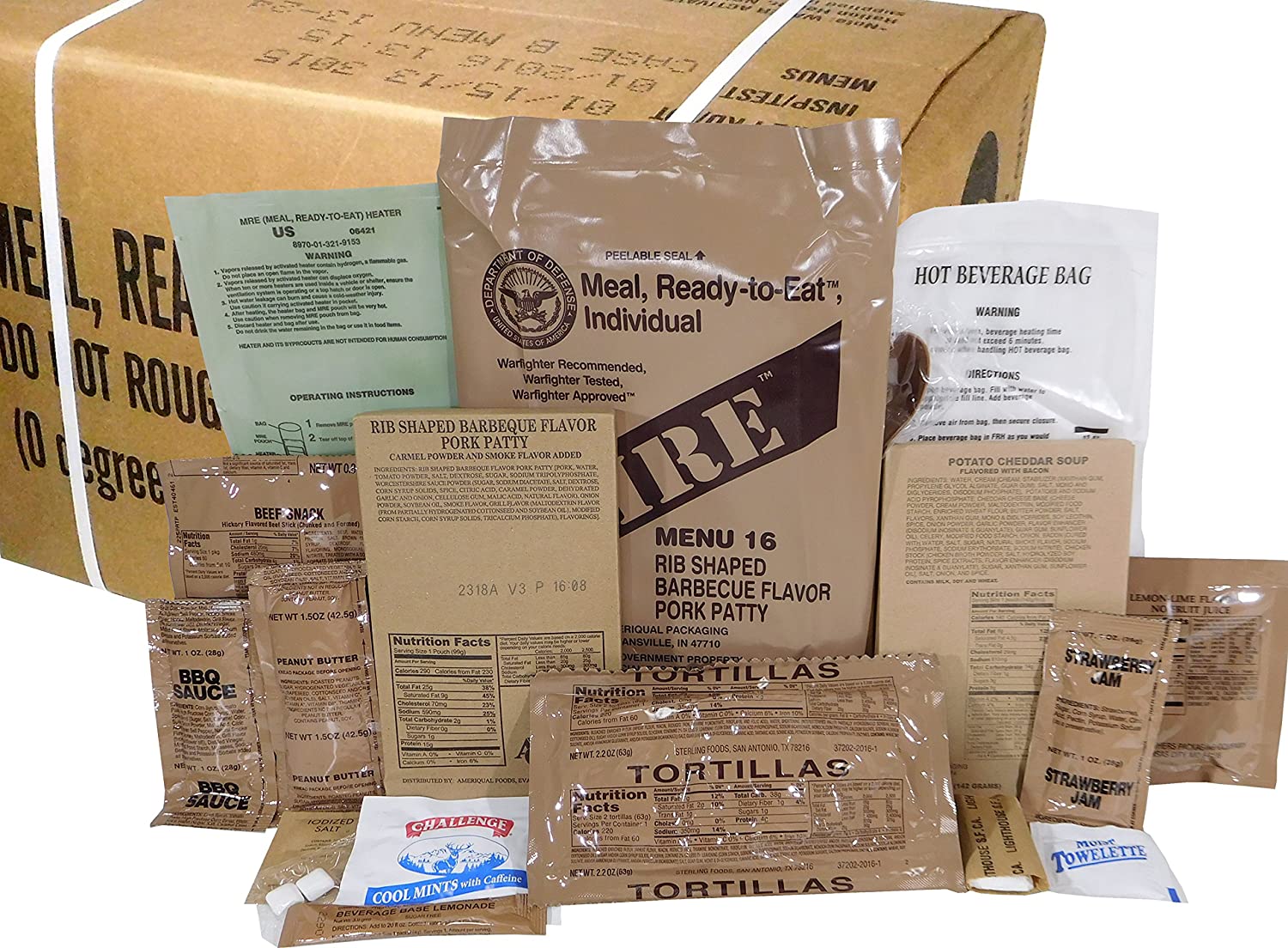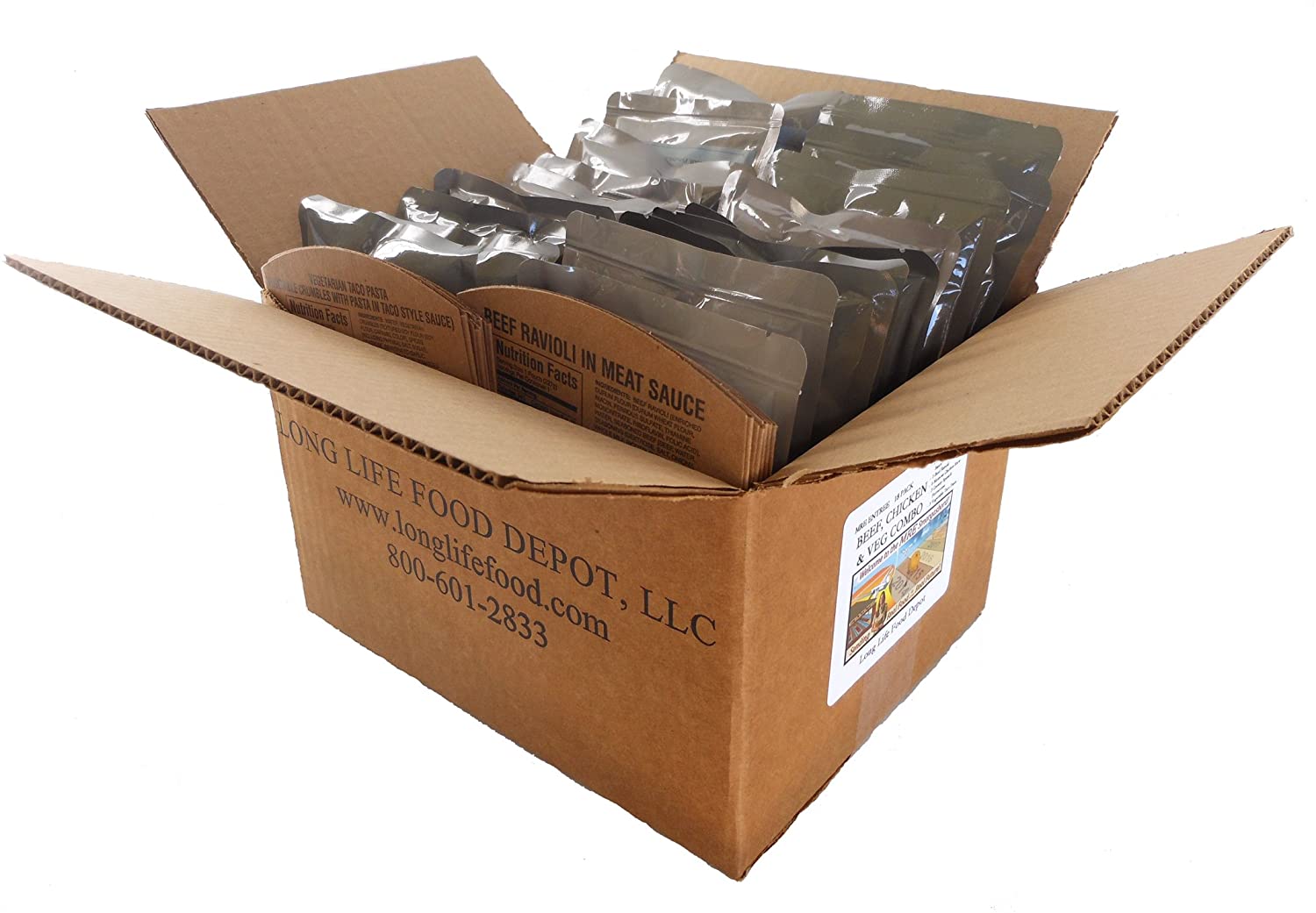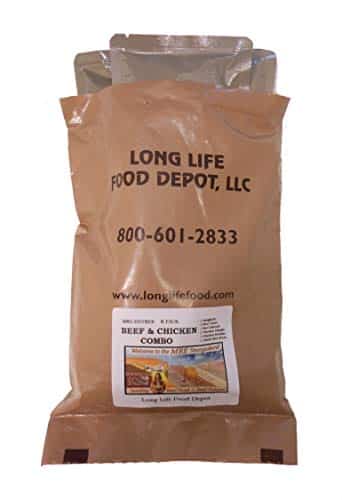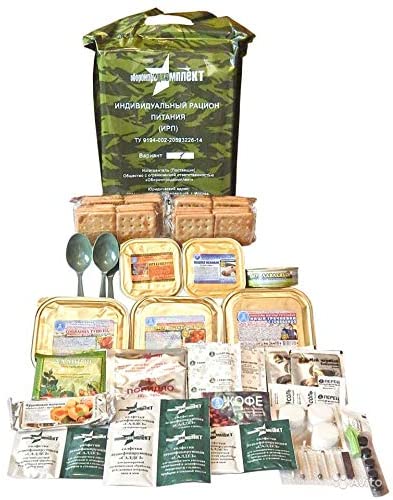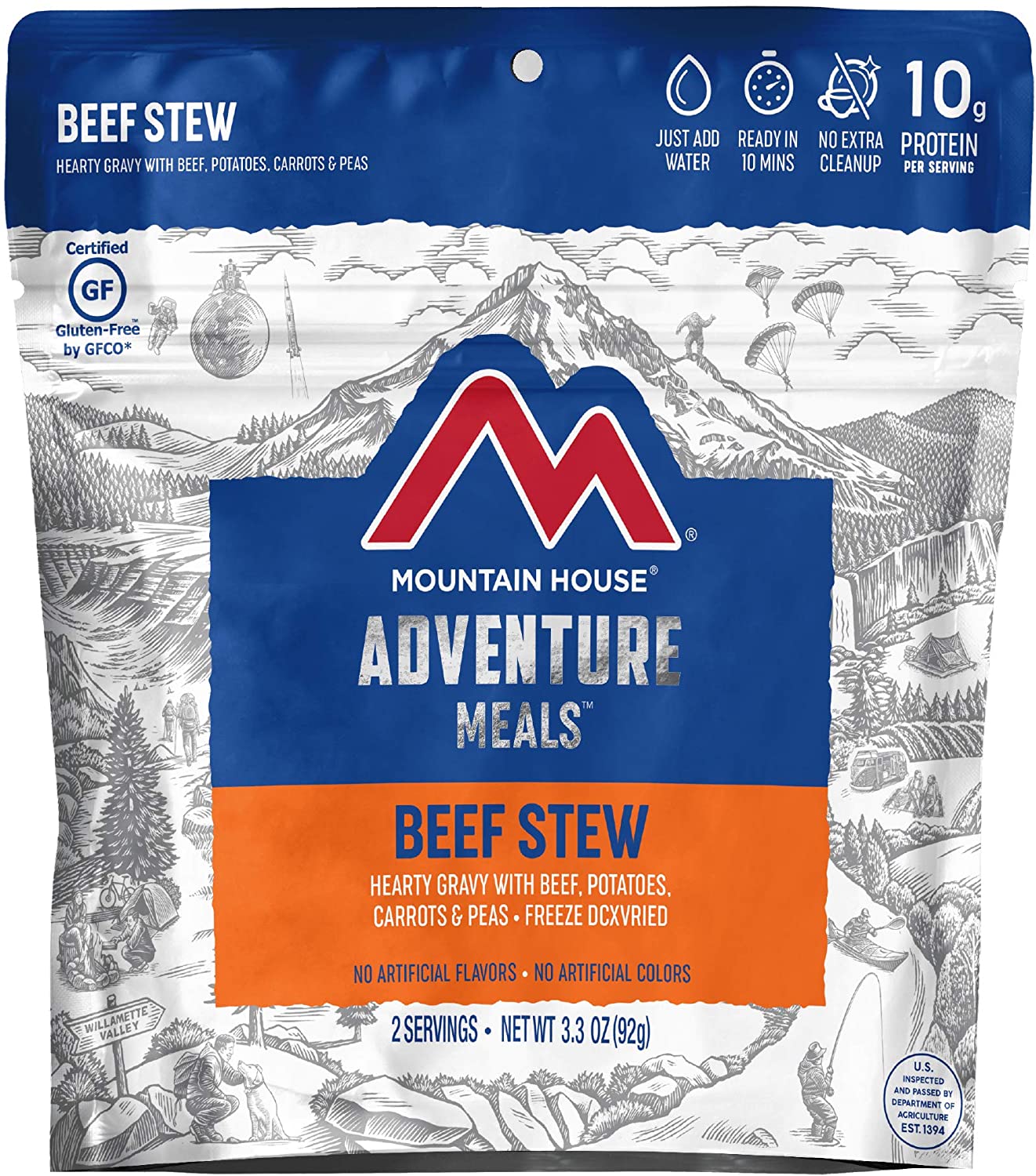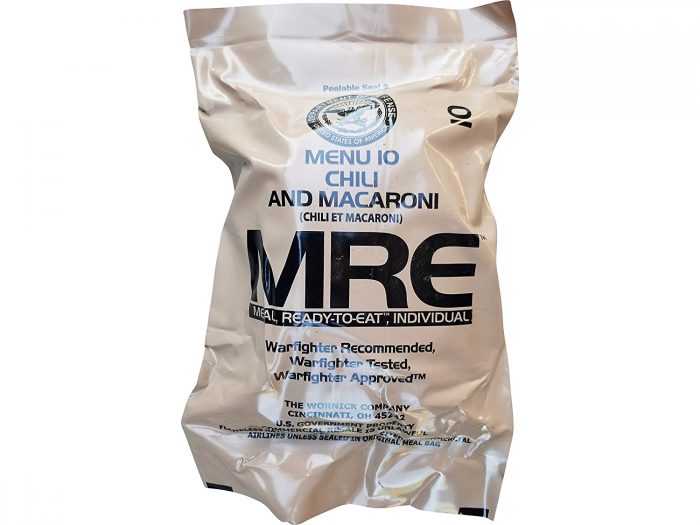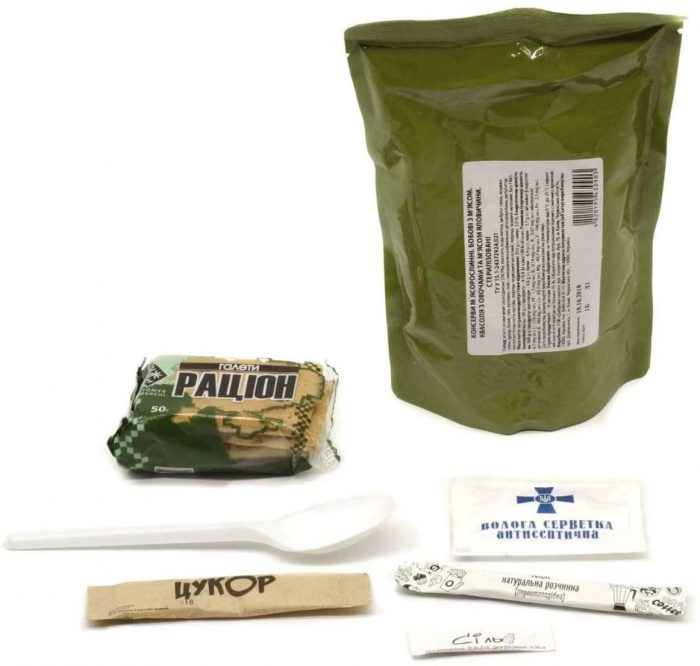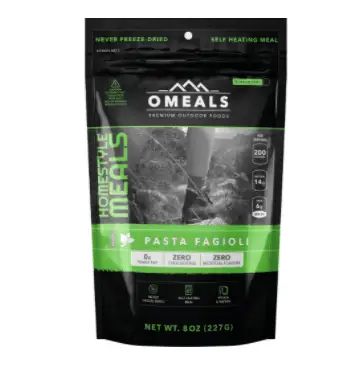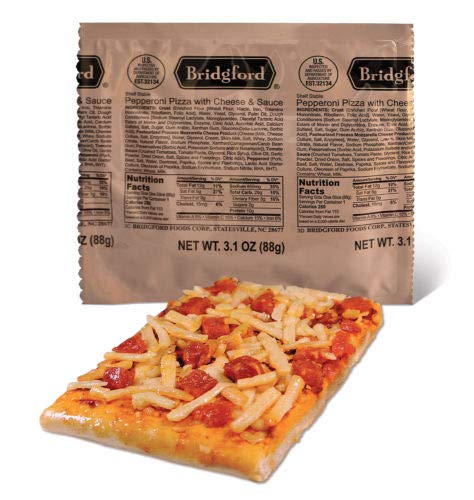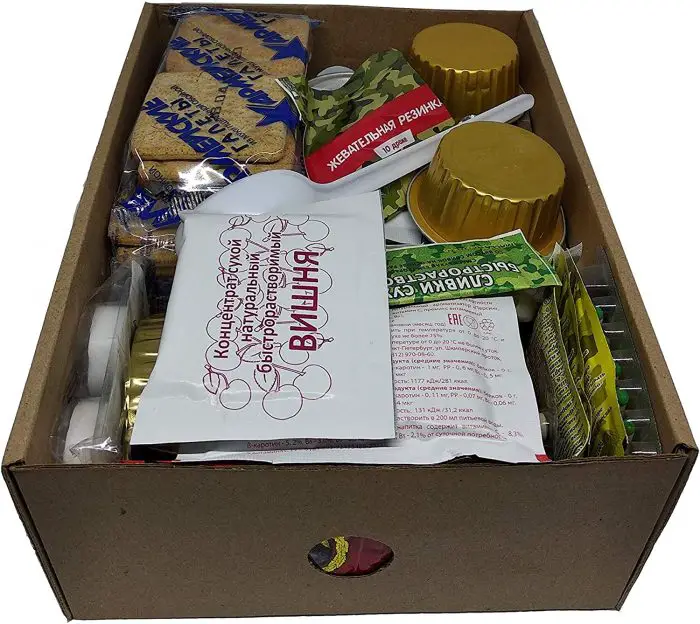In terms of long-term survival necessities, food is one of the things you need to secure- next to water and shelter.
In essence, food is fuel. It’ll sustain you and keep your body running.
This is where MRE meals become an excellent option for emergency preparations.
What is an MRE Meal?

MRE means Meal Ready to Eat.
You can eat its content straight out of its packaging. With sealed airtight packages, it can remain viable for a couple of months.
MREs used to be offered to soldiers and servicemen before. However, these days, civilians can also get their hands on them. They are particularly popular among hunters, campers, bikers, backpackers, hikers, fishermen, and anyone who spends a lot of hours outdoors.
MREs are usually handed out in large packages. Only the entrées are listed on the packaging. There’s no telling what snacks and drinks are included until they open their box.
Although MREs can be consumed after opening, it comes with a heating pouch and it’s quite fascinating. It can warm the entrées to a temperature that’s appetizing to you.
A Brief History
MREs these days look nowhere near as palatable as the first versions released in 1983. In fact, if you can do a quick comparison, you’ll find that modern versions have this subtle “fine dining” vibe. They are a lot more pleasing to the eyes and tastebuds.
In 1907, MREs used to be called the Iron Ration. It included items like wheat and bouillion powder cakes, a bar of chocolate. and packs of salt and pepper.
Fast forward to 1917, MREs were called Reserve Rations. They included cans of hardtack biscuits, canned meat or fresh bacon, ground coffee, sugar, and salt.
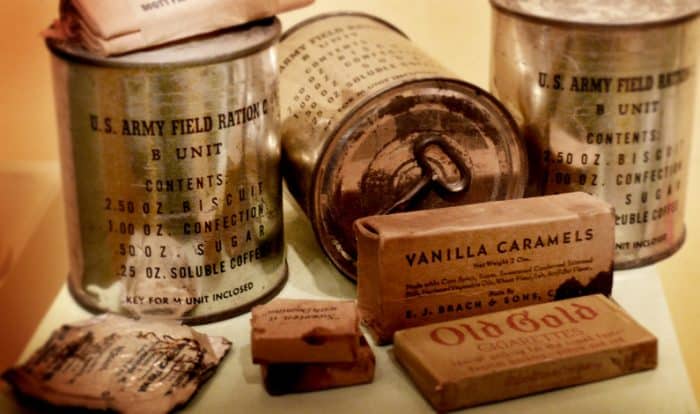
1938’s version is probably the closest to the MREs we see today. It came with individually canned and pre-cooked meals. It was offered in three choices: potato hash and meat, vegetable stew and meat, and beans and meat.
By 1942, the rations increased not just in options but calories, too. They came with three meal options but they still weren’t that appetizing.
In 1975, the Department of Defense adopted MRE as its official combat ration. A few years after, they started their massive industrial-scale production.
By 1981, the first batches of MREs were delivered. Although the servicemen found the food to be acceptable, only half of the MREs delivered were consumed.
The Department of Defense made some changes in hopes to make their rations more acceptable to servicemen. They changed the entree sizes from 5 ounces to 8 ounces. Hot sauce and candies were included. Plus, cold beverages were offered.
Unfortunately, the taste was still the same. MREs still taste quite gross.
By 1994, commercial-like graphi wercse added to MRE packs. It was the DoD’s strategy to boost their acceptance and consumption. The packs were made easier to open, too.
In 1997, the menu was expanded to include 20 entree items. Cheese tortellini and pork chop with noodles were introduced. By 2006, servicemen were offered ‘beverage bags’, allowing them to stop using metal canteen cups.
These days, servicemen can pick from over 24 different entrees. There are also more than 150 supplementary items they can choose from the MRE chain.
Although MREs may still not be that appetizing for a lot of people, they’re still so much better than what soldiers had in 1907.
What Can You Find Inside an MRE?
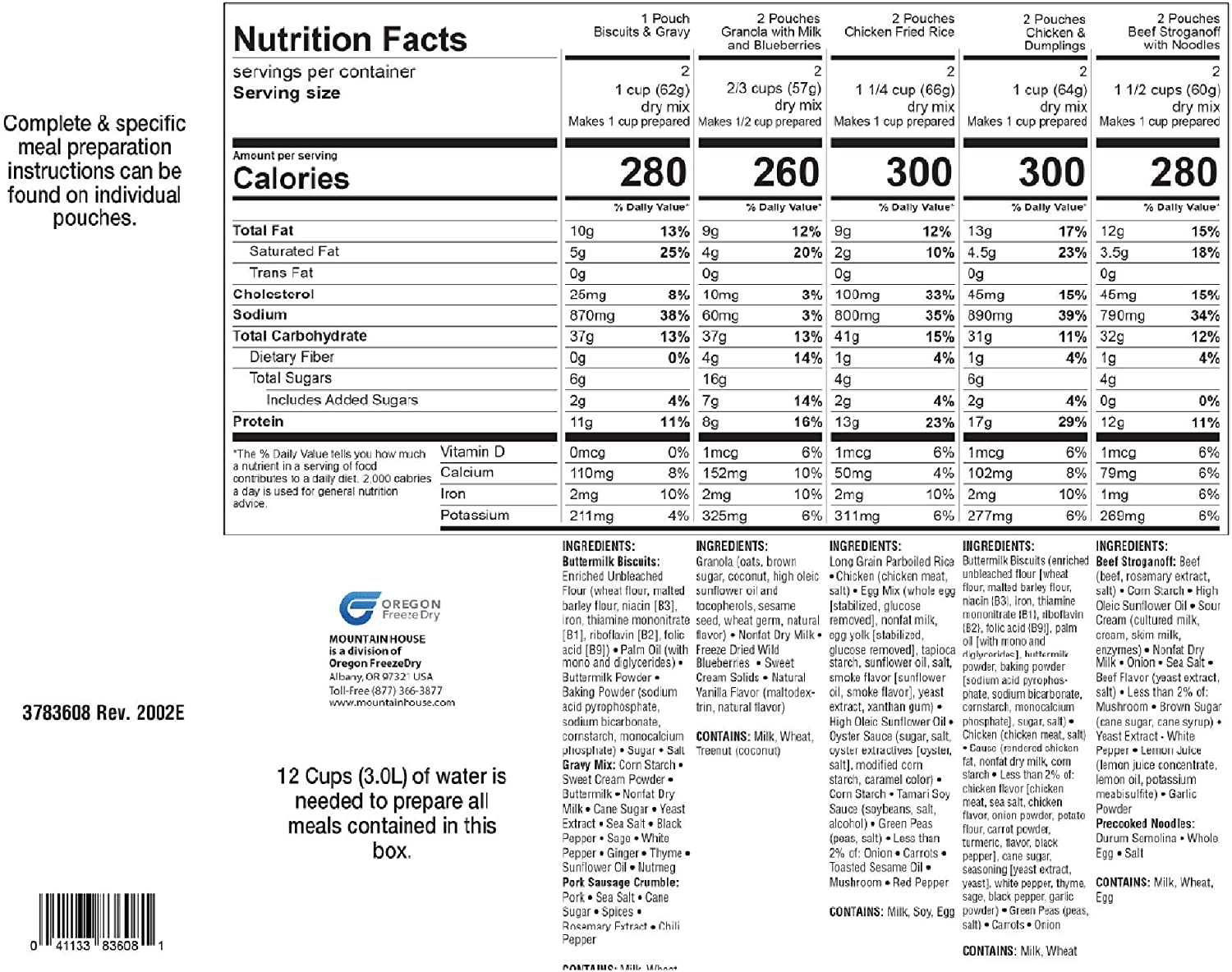
Each MRE pack has about 1,250 calories. It may sound a lot for ordinary people but it’s helpful for servicemen.
In one day, they can burn as much as 4,000 calories. Considering that, it only makes sense for an MRE pack to contain that many calories.
As for MRE’s macronutrient breakdown, below is an overview:
- 53% carbohydrates
- 36% fat
- 13% protein
Now, What Do MRE Packs Contain?
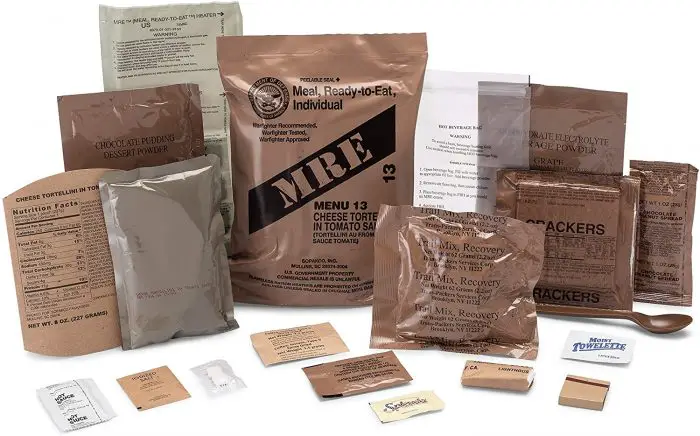
All military MREs come with flameless ration heaters. Once activated, an FRH brings your food to the temperature that’s expected for a nice and decent hot meal.
Each pack comes with instructions on how to add water into the heater and place the food packet inside it. The instructions are easy to understand, even for ordinary people.
Apart from that, most MRE packs come with the following:
● Entrées like beef stew or spaghetti
● Side dishes like corn, mashed potatoes, rice, or fruit
● Bread or cracker
● Spread like cheese spread or peanut butter jelly
● Desserts like pound cake or cookies
● Beverage like tea, coffee, or cocoa,
● Candies like Skittles and M&Ms
● Seasoning
Most MRE meals come with a single utensil and an accessory pack. It contains a matchbook, moist towelette, chewing gum, napkin, and extra seasonings.
What Do They Taste Like?
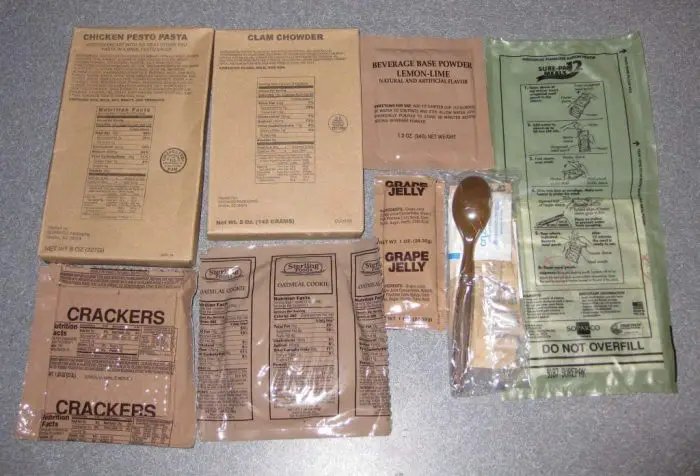
A lot of people don’t like the taste of MREs. Some find them just alright.
To give you an idea, an MRE tastes like any food that comes out of a can.
For example, if you had Thai chicken, you’ll find its taste very similar to chop suey in a can. There’s a lot of mushrooms, chicken, red pepper, and celery in a slightly sweet sauce.
The rice is alright. It comes with peas, wild rice, white rice, and carrots.
If you eat the rice by itself, you may find it a bit dry. However, if you add a bit of sauce, it turns out fine.
The cereal bar that comes in an MRE pack tastes like your regular cereal bar. Crackers taste like the ones you can buy from grocery stores, too.
Take note that not all MREs are great. The way they are stored can affect the texture, consistency, and even the flavor of their contents.
Some people find their MREs a bit runny and watery. Others complain of dryness and blandness.
What to Look For When Buying MRE Meals?
Here’s the thing:
Not all things that are labeled “MRE” are legit MREs. Some are fake packs while others aren’t authentic US military MREs.
What Do Fake Packs Mean?
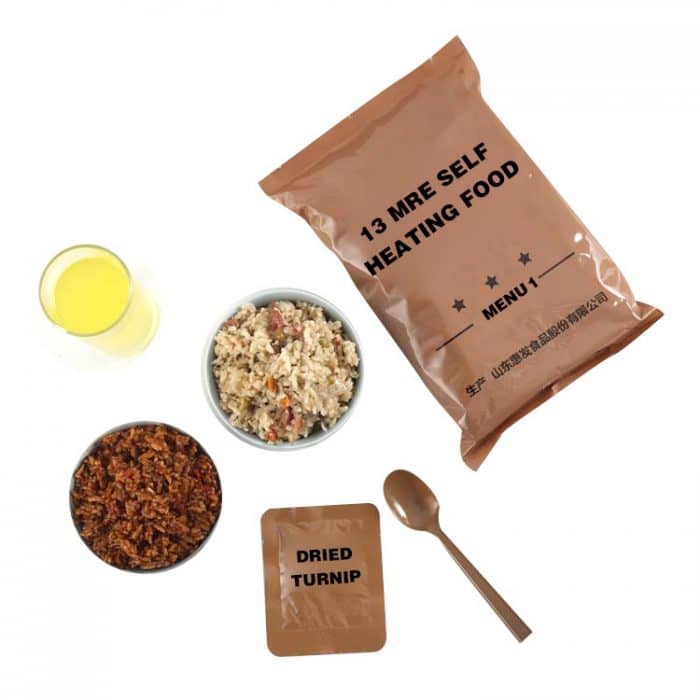
Knock off MREs exist. These are MREs that aren’t packed and sold by the three main MRE manufacturers in the country (more on this later).
If you take a close look, you’ll realize that the difference isn’t that great between a real military MRE and a knock-off pack. Their prices might even be close to each other.
However, you may find the assortment of food a bit different. The amount of food is much less, too.
To help you find real MRE packs, it’s important to look for actual pictures.
As much as possible, avoid auctions or sellers that don’t show any pictures. There’s a good chance that what they’re offering aren’t legit items.
If they are able to show pictures, make sure that it has the following pieces of information:
● Menu types
● Inspection dates
● Date packed
Where to Buy MREs?
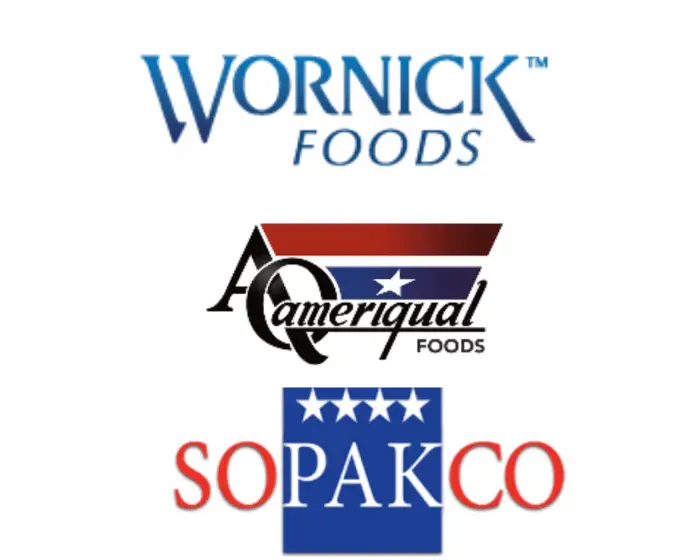
Take note that there are two types of MREs you’ll come across when trying to purchase one. There’s the private label civilian MRE and US military MRE.
In the United States, the DoD purchases their MREs from the following vendors:
● Wornick Foods
● Sopakco
● AmeriQual
Technically, you can’t buy military MREs. However, these companies offer military-grade civilian products for those who want to try out MREs even if they aren’t in the field.
You Can Also Find MREs In The Following Places:
1. Army Surplus Stores
These places almost always have MREs. They are the spots you should go to if you want to purchase a pack and you have the extra budget to do so.
You see, MREs from army surplus stores tend to be expensive. You can find one being sold for no less than $8 each.
2. A person from the military
This is an option you can look into if you know someone who’s on active duty in the military. Part-time reservists and full-time military personnel tend to receive them during their field exercises.
3. Gun shows
Compared with surplus stores, MREs sold at gun shows tend to be cheaper.
4. eBay
This is probably the best place to get an MRE. You’ll find tons of options here. You can even find a case for sale.
The downside is the authenticity of the MREs you can find there. Not all packs being sold on eBay are authentic. Safety is a big concern, too. There are people who sell really old MRE packs to people.
How to Heat MRE Meals
There are a couple of ways you can get an MRE. The most common method involves the use of Flameless Ration Heaters.
If you choose to use an FRH, here’s how you can heat your pack:
- Take out the pouch from its outer cardboard box.
- Slide the pouch into the heater’s plastic sleeve
- Get about 1 to 2 tablespoons of water and pour it inside the heater. Then, place it into the cardboard box. As soon as you add the water, the chemical reaction will start.
- Hold the cardboard box at a 45-degree angle. You can rest it against a vertical surface.
- Leave the pouch to heat for about 3 to 7 minutes.
- Carefully take out the heater from the box. Do the same thing to the MRE pouch. Take note that the items will be super hot.
- Cut open the pack with care.
- Finally, enjoy your meal.
Using A Saucepan
- Take out the MRE pouch from its cardboard box.
- Open the pouch and empty its content in your saucepan.
- Heat it for about 5 minutes with medium to medium-high heat.
- Remove the saucepan and transfer your meal into a clean dish.
Using An Oven
- Take out the MRE pouch from its cardboard box.
- Open the pouch and pour the content into an oven-safe dish. Remember not to heat the actual MRE pouch in your oven.
- Set the oven to 350° and heat for 7 to 10 minutes.
- Remove the dish from the oven and be ready to eat.
Using A Microwave
- Take out the pouch from the cardboard box.
- Open the pouch and pour the contents into a microwave-safe dish. Don’t put the pouch directly into your oven.
- Set your microwave oven on high and heat the contents for 2 to 3 minutes.
- After that, carefully take out the dish from the microwave and serve.
In Boiling Water
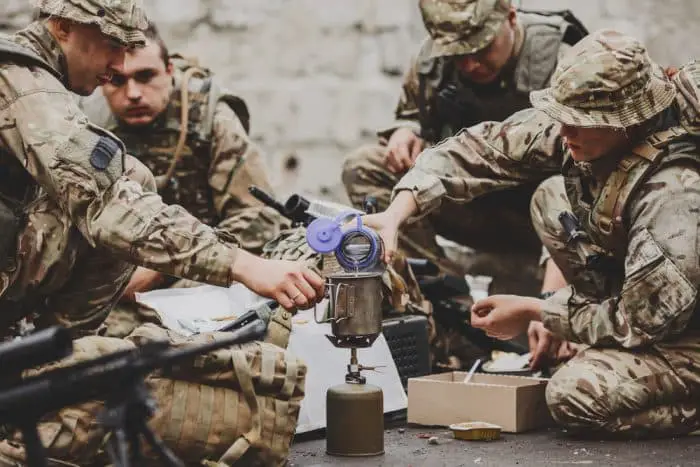
1. Start by filling your saucepan with water. Make sure to only fill it halfway.
2. Bring the water to a boil using a burner or your stovetop.
3. Once boiling, you can reduce the heat to medium or medium-high.
4. Take out the MRE pouch from the box and place it into the boiling water.
5. Let it stay in the saucepan for about 5 to 8 minutes.
6. Remove the pan from the burner and pour the water out. This will make it easy for you to remove the pouch.
7. Once out of the water, open the pouch and your MRE is ready.
How Long Do MREs Last?
The shelf life of MRE meals is highly affected by temperature.
If you store your pack at 100 degrees Fahrenheit, it will only be viable for around 9 months. If you keep it at room temperature, it can last for at least three years.
If you want your pack to last for several years, you can consider refrigerating it.
Compared with older versions, modern MRE packs have a shorter lifespan. This is partly due to the change in ingredients. Back then, MREs are made with freeze-dried ingredients which generally last longer.
Now, How Do You Figure Out If Your MRE Pack Is Still Good To Consume?
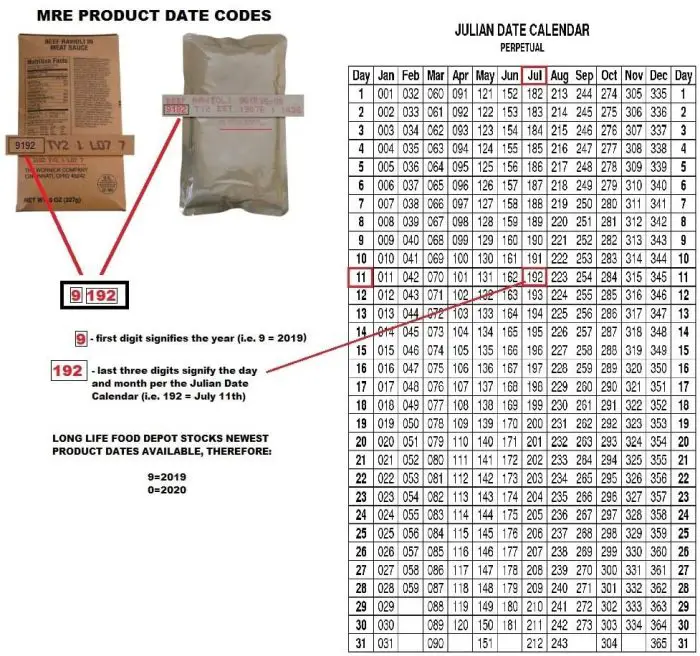
You’ll have to look at the main package. There, you should be able to see a four-digit Julian code.
The first digit runs from 0 to 9 while the remaining numbers run from 1 to 365.
The first digit identifies the year of production. The last three numbers refer to the day of the year of production.
Apart from that, you may also see an inspection date. This refers to the date the MRE pack needs to be inspected if they were placed in storage.
How to Store MREs
As mentioned, hot places are not the ideal spots to store MREs. They have low moisture content which means you have to store them in a cool dark place.
Although you can freeze the packs, it’s not recommended to thaw and refreeze them a couple of times. It’ll greatly increase the failure rate of the packaging since it wasn’t created to handle the sharp edges and irregular shapes that freezing water causes.
If you want to keep your MRE pack viable for a long time, you can put it in the freezer and leave it there. Take note of what you put on and around it.
How Healthy are MREs
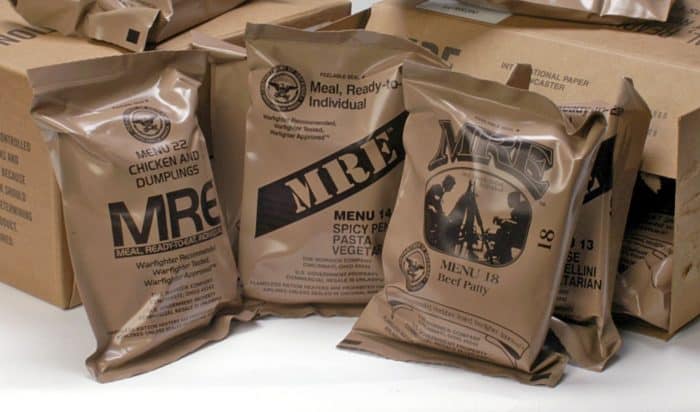
If you compare eating MREs with eating fresh fruits and vegetables, the answer would be no.
However, with their calorie content and shelf life, they serve their purpose. A soldier who eats three MRE meals in a single day should be getting the recommended daily allowance of calories, vitamins, and minerals as recommended by the military.
MREs, in general, are not supposed to be served as daily meals. They are only offered to soldiers to help them get through their present mission.
Now, if you are considering eating MREs, you have to understand that it’ll have a negative effect on your bowel movement. Based on research, MREs can make your poop very hard because they don’t have the good bacteria that can be found in fresh foods.
Can You Eat MREs For A Long Time?
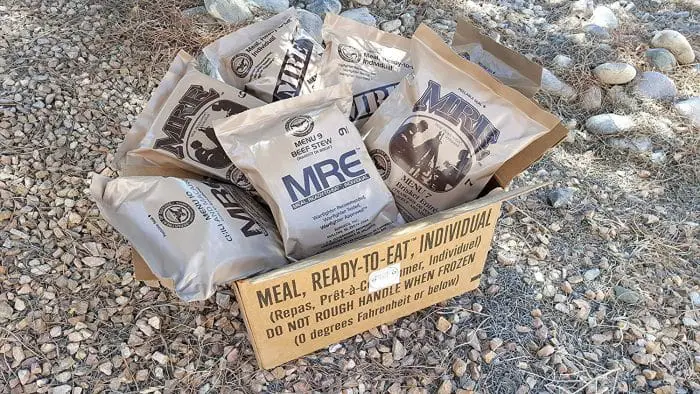
If you find yourself in a situation where you have no other option but to eat MREs for several days, there are things you can do to minimize its effect on your digestive system.
Because constipation is a serious problem with the long-time consumption of MREs, make sure to take a good multivitamin. It’ll fill in the nutritional gaps your body may experience with eating pure MREs for days.
It’s also a good idea to take fiber supplements. They can make it easy for you to pass stool.
Take note that eating lots of MREs can be very bad for your stomach. It can upset the organ, causing other illnesses like Irritable Bowel Syndrome and Celiac Disease.
MREs vs Freeze-Dried and Dehydrated Foods

MREs are designed for quick meals without the need for any special preparation. They can be consumed hot or cold, making them great when you’re out on a mission or you’re faced with a short-term emergency.
Freeze-dried foods, on the other hand, have up to 99% of their water or moisture removed. They undergo sublimation or freeze-drying which involves preparing, seasoning, cooking, and flash freezing them. The entire process can take anywhere between 24 to 48 hours.
With freeze-drying, food items are able to retain their flavor, shape, and texture. Plus, they’re super lightweight, too.
You can reconstitute them in just 5 to 10 minutes. All you need to do is add hot water.
Government Issued Military MREs vs Commercial Civilian MREs
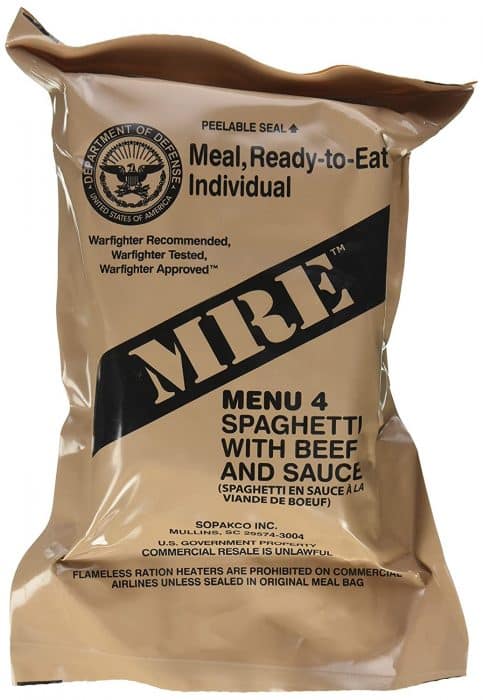
Let’s start with the shelf life of the MRE packs.
Civilian and military MREs generally last for a couple of years.
But here’s the thing:
Since soldiers are positioned in warm to hot places, they are only able to keep their MREs for a few months. Civilians, on the other hand, can store their packs at a more favorable temperature, allowing them to last longer.
Civilian and military MREs don’t have the same packaging.
For one, military MRE packs specifically state that they are not for resale. They are just for soldiers and servicemen.
Meanwhile, civilian MREs have fancier packaging. They have the company’s name as well as their phone number, website, and other important details. They may even have logos on them.
Apart from that, civilian MREs aren’t restricted like the military ones. You can get them from legitimate dealers and online sellers.
Since there are no restrictions, it’s easy for some people to sell MREs that aren’t authentic. Some of them even sell MREs that are way over their expiration date. Eating these MREs can cause health problems like diarrhea and food poisoning.
Why are MRE meals great for survival?
MRE meals are good for emergency situations because they last long. If kept in the right conditions, they can last several years.
Plus, they’re cheap. Most people who sell them online offer them in packs. When you buy a package, you can get four to twenty pouches. And the more items you buy, the more money you’ll be able to save.
Another great thing about MREs is their portability. They are designed to be carried in the field and through hard missions. This means that you can carry them over long and hard distances with no difficulties.
They are also easy to consume. There’s no spilling or mess as long as you know how to open and heat the contents.
The 11 Best MRE Meals
1. Long Life Food Depot MRE Beef & Chicken Entrees Combo
Fakespot score: A
Long Life Food Depot MRE Beef & Chicken Entrees Combo contains 3 beef strips, 2 chili with beans, 2 beef stew, and 3 shredded beef. You can also find 3 beef goulash, 1 Mexican chicken stew, and 4 chicken chunks.
For the most part, the meals are great. They taste good whether reheated or cold, making them perfect for eating anytime or even during an emergency. The meals are sealed properly, too.
If you are thinking of taking these with you during backpacking, you may want to think twice. There’s not a lot of calories per pack. Plus, they’re quite heavy as well. Each pack weighs about 8 ounces.
2. IRPRUS Military MRE
Fakespot score: B
This ration pack can make you feel a bit uncomfortable, but the meals are totally worth trying out. The labeling is entirely in Russian so there’s no way to tell what’s inside just by looking at the packaging.
However, you’ll be surprised when you open the pack. Inside, you’ll find three complete meals that should last for an entire day.
Plus, you’ll also get towels and cutlery. These things may seem minor but they’re a huge help when you’re outdoors and trying to survive.
The packaging is waterproof. It also comes with a zip lock gripper for your convenience.
The meals taste decent. Just take note that the crackers may taste a bit bland.
3. Mountain House Beef Stew
Fakespot score: B
One of the best things about the food items inside this pack is that they’re made with no artificial flavors. They are also certified gluten-free.
Each pack comes with two total servings. It’s great if you’re out camping with a friend or you just tend to eat more than usual when outdoors.
The meals are easy to prepare. All you need to do is add hot water to the pouch and wait for 10 minutes. After that, your food should be warm enough to eat.
The packaging can be recycled to help reduce waste. The pouch is also lightweight so you can take it with you during your trips.
4. Wornick-Chilli-Mac MRE
Fakespot score: A
This MRE pack is created to help you survive during harsh conditions. You can take it with you when camping or hiking. It has a long shelf life which makes it excellent for emergencies.
Per meal, you’ll get about 1250 calories. And for this particular pack, the contents are quite decent. In fact, it’s probably the best on the menu.
With the Chili Mac, you’ll get generic crackers, lemon Poppyseed pound cake, tropical fruit drink, beef stick, Skittles, and 2 cheese spreads. There’s also a standard accessory pack.
5. Ukrainian Army MRE Armed Forces 24-Hour Combat Ration Pack
In terms of flavor, this one doesn’t disappoint. It’s actually very tasty. The packaging is nice, too.
The meals are completely ready to eat. In fact, you can eat them straight out of the packaging.
In terms of nutrients and calories, each pack has enough to keep you moving in any kind of situation.
The pack comes with a small stove with matches and fuel tablets. Take note that they’re not that easy to use. The flame tends to get a bit high which can easily burn food.
6. Wise Open Range Cheesy Potato Soup
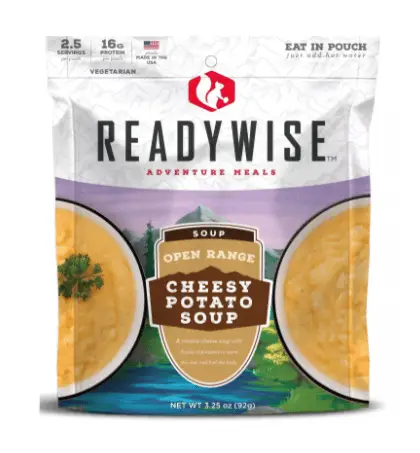
Each pouch has 2.5 servings. If you are outdoors and you’re not able to finish everything, you can keep the leftover inside the pouch. It’s resealable so you won’t have to worry about it leaking.
The pouches are lightweight. They are portable enough for any emergency condition or outdoor adventure.
To prepare the meal, just add water. There’s no need to have a separate plate since it’s made to be eaten directly from the pouch.
7. OMEALS 8 oz. Pasta Fagioli
It’s hard to find a decent option for vegetarians so this one’s definitely a treat. It’s delicious and comforting- the exact kind of food you need during an outdoor activity or emergency.
It comes with waterproof and lightweight packaging for convenience. It lets you dine wherever you want.
The meal is fully cooked and not freeze-dried. It comes with different seasonings so you can adjust the flavor according to what your tastebuds want.
Per serving, you’ll get 6 grams of fiber, 14 grams of protein, and 200 calories.
8. AlpineAire Foods Pepper Beef with Rice Dehydrated Food

Even though this is a dehydrated food option, it actually tastes good. It comes with seasoned rice, red and green bell peppers, beef, and light black pepper sauce.
Each package has 620 calories and 28 grams of protein. Take note that this is a gluten-free option. It was made with no artificial preservatives, colors, or flavors.
9. XMRE 1300XT
Fakespot score: B
The packs are US military -MREs. They’ve been tested according to the standards set by the U.S Army.
Each case has 12 rations and 6 different menu options. In every meal, you’ll get about 1,200 to 1,500 calories.
With proper storage, the packs can last for 3 years. That’s a decent shelf-life for people who are planning on buying them for emergency preparedness.
10. Bridgford Pepperoni Pizza With Cheese
You don’t have to miss your favorite pizza just because you’re hiking or camping. This MRE survival pack comes with 3 pieces of Pepperoni Pizza with Cheese and Sauce.
Each serving has 10 grams of protein and 280 calories. That’s a decent nutritional benefit from one tasty snack.
There’s no heating required to enjoy the MRE. You can just open the packaging and eat.
11. Russian Army Daily Ration IRP Meal
Fakespot score: B
This MRE pack comes with a lot of food. There are several drink mixes and food varieties. It’s definitely a filling option for people who go fishing, hunting, or camping.
Taste and flavor are nice, too. You may find the desserts a bit short but the meals are filling. There are three full meals that should last for an entire day.

